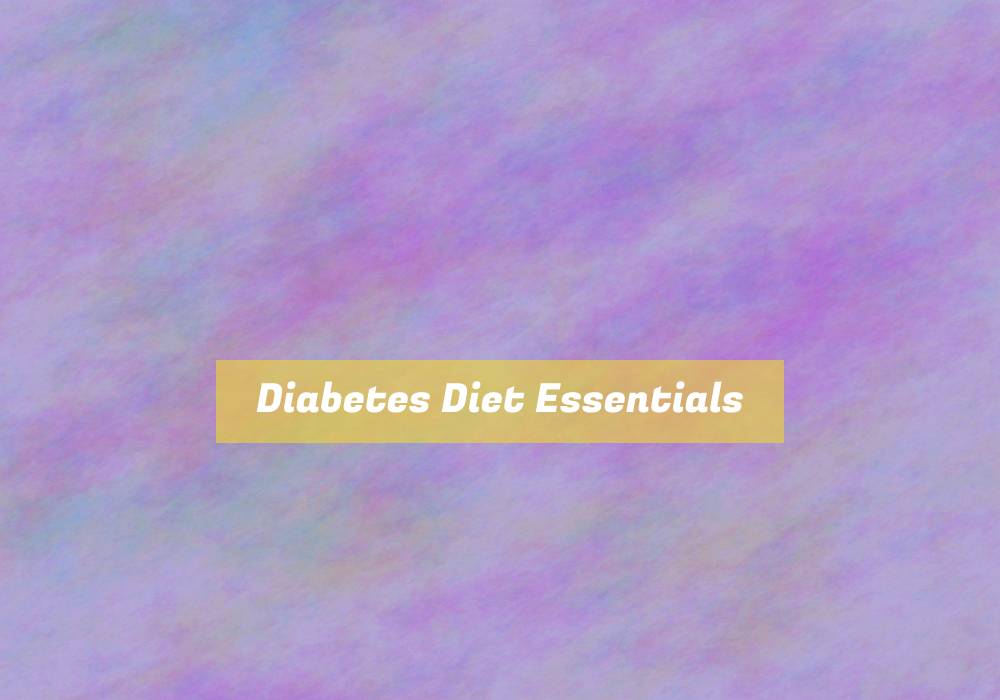Diabetes Diet Essentials
Are you tired of feeling overwhelmed by conflicting information about managing your diabetes through diet? With so many diets and food trends out there, itG??s easy to feel lost.
But what if there were simple, essential guidelines that could help you navigate the world of food without adding unnecessary stress to your life?
In this discussion, weG??ll explore four key essentials that can make a significant difference in managing your diabetes. These essentials will not only improve your blood sugar control but also enhance your overall well-being.
Understanding Carbohydrate Management
To effectively manage your diabetes, understanding how to control your carbohydrate intake is essential. Carbohydrates have the most immediate impact on your blood sugar levels. Monitoring and managing your carbohydrate intake can help you keep your blood sugar levels within the target range.
Start by learning which foods contain carbohydrates. These include grains, starchy vegetables, fruits, dairy, and sweets. Reading food labels can also help you identify the carbohydrate content in packaged foods.
ItG??s important to spread your carbohydrate intake throughout the day to avoid spikes in your blood sugar levels. This means choosing complex carbohydrates that are high in fiber, as theyG??re digested more slowly and have a gentler effect on blood sugar.
Additionally, be mindful of portion sizes. Measuring your food and using tools like a food scale or measuring cups can help you control your carbohydrate intake.
Incorporating Healthy Fats
Understanding how to incorporate healthy fats into your diet is crucial for managing diabetes and maintaining stable blood sugar levels. Healthy fats play a key role in improving insulin sensitivity and reducing the risk of heart disease, which is common among people with diabetes. When choosing fats, opt for sources like avocados, nuts, seeds, and olive oil. These contain monounsaturated fats that can help lower bad cholesterol levels and reduce inflammation. Additionally, fatty fish such as salmon, mackerel, and sardines are rich in omega-3 fatty acids, which have been shown to lower the risk of heart disease and improve blood sugar control.
Be mindful of portion sizes when consuming healthy fats, as theyG??re high in calories. A general rule of thumb is to aim for around 2-3 servings of healthy fats per day. This could be in the form of adding a handful of nuts to your breakfast, drizzling olive oil over your salad, or incorporating avocado into your lunch.
Emphasizing High-Fiber Foods
When emphasizing high-fiber foods in your diabetes diet, focus on incorporating a variety of whole grains, legumes, fruits, and vegetables into your meals.
Whole grains such as brown rice, quinoa, and oats are excellent sources of fiber and can help regulate blood sugar levels.
Legumes like lentils, chickpeas, and black beans are also high in fiber and protein, making them great choices for managing diabetes.
Additionally, fruits such as berries, apples, and pears, as well as vegetables like broccoli, Brussels sprouts, and spinach, are high-fiber options that can be included in your daily meals.
High-fiber foods are beneficial for individuals with diabetes because they can help control blood sugar levels, improve digestion, and contribute to a feeling of fullness, which can aid in weight management.
When planning your meals, aim to include a variety of high-fiber foods to ensure youG??re getting a good balance of nutrients.
Monitoring Portion Sizes
Keep your portion sizes in check by using smaller plates and bowls to help control your food intake. This simple trick can make it easier to avoid overeating. When dishing up your meals, visualize that half of your plate should be non-starchy vegetables, a quarter should be lean protein, and the remaining quarter should be whole grains or starchy vegetables. This approach helps to ensure a balanced and nutritious meal while keeping portion sizes in check.
Additionally, be mindful of serving sizes when eating snacks. Instead of munching straight from a large bag or box, take a small portion and put the rest away. This prevents mindless eating and helps you keep track of how much youG??re consuming.
When dining out, consider sharing a main dish with a friend or packing half of it to go before you start eating. By being aware of portion sizes and making small adjustments, you can better manage your food intake and improve your overall diabetes management.
Conclusion
In conclusion, managing your diabetes through diet involves understanding carbohydrate management, incorporating healthy fats, emphasizing high-fiber foods, and monitoring portion sizes.
By making these essential changes to your diet, you can better control your blood sugar levels and improve your overall health.
Remember to consult with a healthcare professional for personalized advice and support on creating a diabetes-friendly meal plan that works best for you.
With dedication and the right approach, you can successfully manage your diabetes through a healthy diet.








I really appreciate the way you’ve approached the often daunting topic of diabetes management through diet. It’s so true that with an endless stream of conflicting information about what to eat, it can feel like navigating a minefield. I’ve been living with diabetes for a few years now, and I remember the beginning of my journey feeling like I was on information overload. The countless diets, trends, and contrasting recommendations left me confused more than anything else.
Navigating diabetes management can really feel overwhelming at first. It’s understandable; with so many diets and conflicting advice out there, figuring out what works for you can seem impossible. One thing that has helped me and others is focusing on whole foods—fruits, vegetables, lean proteins, and whole grains. These can stabilize blood sugar levels without the need for strict rules or drastic changes.
Your post raises an important point about the confusion many people face with dietary advice for managing diabetes. I can relate to this feeling, having navigated the waters of various diets myself. It becomes overwhelming when each new trend proposes a different approach to carb management.